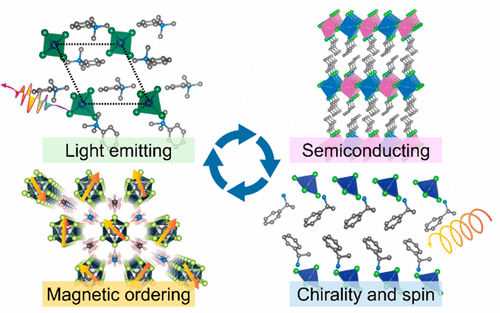当前位置:
X-MOL 学术
›
Acc. Mater. Res.
›
论文详情
Our official English website, www.x-mol.net, welcomes your
feedback! (Note: you will need to create a separate account there.)
The Renaissance of Functional Hybrid Transition-Metal Halides
Accounts of Materials Research ( IF 14.0 ) Pub Date : 2022-03-09 , DOI: 10.1021/accountsmr.1c00270 Lingling Mao 1 , Jian Chen 1 , Pratap Vishnoi 2 , Anthony K. Cheetham 3, 4
Accounts of Materials Research ( IF 14.0 ) Pub Date : 2022-03-09 , DOI: 10.1021/accountsmr.1c00270 Lingling Mao 1 , Jian Chen 1 , Pratap Vishnoi 2 , Anthony K. Cheetham 3, 4
Affiliation

|
There is an extensive history of research on both inorganic and hybrid metal halides, with the latter being first reported in the 1960s. Although work on hybrid systems has progressed steadily over the last 60 years, it has enjoyed a major renaissance during the last 5 years. This has arisen as a consequence of the 2009 discovery of the outstanding optoelectronic properties of hybrid lead halides, such as (MA)PbI3 (MA = methylammonium), and the recognition that there are many opportunities for equally exciting discoveries with compounds of the transition metals. Some of the early work on hybrid transition-metal halides put more emphasis on crystal structures but less on properties. In the modern era, we aim to grasp both the structure and properties, with a new twist. In this Account, we shall explore the recent developments in hybrid transition-metal halides with a focus on work in four main areas: magnetism, photoluminescence, semiconductivity, and spintronics. Our work on magnetism centers on the Ru-based hybrid halides, where the structural types are diversely composed of vacancy-ordered double perovskite, as well as chain-like one-dimensional structures and layered double perovskite (LDP) when paired with a (1+) metal. We explore their magnetic properties and find that their spin–orbit coupling (SOC) behavior can be tuned through changing the A cation and the halide. In the luminescence section, we focus on our recent works on hybrid tetrahedral Mn(II) bromides and Cu(I) and Ag(I) iodides. We correlated our newly discovered 0D AmMnBr4 (A = organic cation, m = 1 or 2) compounds with previous reports, and generated a trend where the photoluminescence quantum yield (PLQY) increases with larger Mn–Mn distances. The flexible organic cation becomes the most important tool here to tune the structure–PLQY relations. Cu(I) and Ag(I) iodides coordinated with iodides and organic ligands produce new crystal structures with intense PL. For the semiconducting properties, we explore the Pt-based vacancy-ordered double perovskite and hybrid bismuth and indium-based LDPs to show the structural evolution with different choices for the organic cation, the metal and the halide; these have a strong influence on the optical properties. The LDPs specifically exhibit high structure tunability, with a wide range of (1+) and (3+) metal choices, and are exempt from some of the limitations of 3D double perovskite. In the last section, we introduce the recent progress on hybrid transition-metal-based ferroelectrics and spintronic materials. We successfully demonstrate the utilization of chiral Cu(II) chlorides for circularly polarized light (CPL) detection, showing the high anisotropy of the photoresponsivity. We also highlight the work that the authors have contributed in these areas and suggest several exciting opportunities for future developments.
中文翻译:

功能性混合过渡金属卤化物的复兴
无机和杂化金属卤化物的研究历史悠久,后者于 1960 年代首次报道。尽管在过去 60 年中,混合动力系统的工作稳步推进,但在过去 5 年中经历了一次重大复兴。这是由于 2009 年发现混合卤化铅(如 (MA)PbI 3 )的出色光电特性而产生的(MA = 甲基铵),并认识到过渡金属化合物有许多同样令人兴奋的发现机会。一些关于混合过渡金属卤化物的早期工作更多地强调晶体结构,而不是性质。在现代,我们的目标是同时掌握结构和特性,以新的方式。在本文中,我们将探讨混合过渡金属卤化物的最新发展,重点关注四个主要领域的工作:磁性、光致发光、半导体和自旋电子学。我们在磁性方面的工作集中在基于 Ru 的杂化卤化物上,其中结构类型由空位有序双钙钛矿、链状一维结构和层状双钙钛矿 (LDP) 与(1 +) 金属。我们探索了它们的磁性,发现它们的自旋轨道耦合 (SOC) 行为可以通过改变 A 阳离子和卤化物来调节。在发光部分,我们专注于我们最近关于混合四面体 Mn(II) 溴化物和 Cu(I) 和 Ag(I) 碘化物的工作。我们关联了我们新发现的 0DA m MnBr 4 ( A = 有机阳离子,m= 1或2)与先前报道的化合物,并产生了光致发光量子产率(PLQY)随着较大的Mn-Mn距离而增加的趋势。柔性有机阳离子成为调整结构-PLQY 关系的最重要工具。与碘化物和有机配体配位的 Cu(I) 和 Ag(I) 碘化物产生具有强烈 PL 的新晶体结构。对于半导体性能,我们探索了 Pt 基空位有序双钙钛矿和混合铋和铟基 LDPs,以展示有机阳离子、金属和卤化物的不同选择的结构演变;这些对光学特性有很大的影响。LDPs 特别表现出高结构可调性,具有广泛的 (1+) 和 (3+) 金属选择,并且不受 3D 双钙钛矿的一些限制。在最后一节中,我们介绍了基于混合过渡金属的铁电体和自旋电子材料的最新进展。我们成功地展示了手性氯化铜(II)在圆偏振光(CPL)检测中的应用,显示出光响应性的高各向异性。我们还强调了作者在这些领域所做的贡献,并为未来的发展提出了几个令人兴奋的机会。
更新日期:2022-03-09
中文翻译:

功能性混合过渡金属卤化物的复兴
无机和杂化金属卤化物的研究历史悠久,后者于 1960 年代首次报道。尽管在过去 60 年中,混合动力系统的工作稳步推进,但在过去 5 年中经历了一次重大复兴。这是由于 2009 年发现混合卤化铅(如 (MA)PbI 3 )的出色光电特性而产生的(MA = 甲基铵),并认识到过渡金属化合物有许多同样令人兴奋的发现机会。一些关于混合过渡金属卤化物的早期工作更多地强调晶体结构,而不是性质。在现代,我们的目标是同时掌握结构和特性,以新的方式。在本文中,我们将探讨混合过渡金属卤化物的最新发展,重点关注四个主要领域的工作:磁性、光致发光、半导体和自旋电子学。我们在磁性方面的工作集中在基于 Ru 的杂化卤化物上,其中结构类型由空位有序双钙钛矿、链状一维结构和层状双钙钛矿 (LDP) 与(1 +) 金属。我们探索了它们的磁性,发现它们的自旋轨道耦合 (SOC) 行为可以通过改变 A 阳离子和卤化物来调节。在发光部分,我们专注于我们最近关于混合四面体 Mn(II) 溴化物和 Cu(I) 和 Ag(I) 碘化物的工作。我们关联了我们新发现的 0DA m MnBr 4 ( A = 有机阳离子,m= 1或2)与先前报道的化合物,并产生了光致发光量子产率(PLQY)随着较大的Mn-Mn距离而增加的趋势。柔性有机阳离子成为调整结构-PLQY 关系的最重要工具。与碘化物和有机配体配位的 Cu(I) 和 Ag(I) 碘化物产生具有强烈 PL 的新晶体结构。对于半导体性能,我们探索了 Pt 基空位有序双钙钛矿和混合铋和铟基 LDPs,以展示有机阳离子、金属和卤化物的不同选择的结构演变;这些对光学特性有很大的影响。LDPs 特别表现出高结构可调性,具有广泛的 (1+) 和 (3+) 金属选择,并且不受 3D 双钙钛矿的一些限制。在最后一节中,我们介绍了基于混合过渡金属的铁电体和自旋电子材料的最新进展。我们成功地展示了手性氯化铜(II)在圆偏振光(CPL)检测中的应用,显示出光响应性的高各向异性。我们还强调了作者在这些领域所做的贡献,并为未来的发展提出了几个令人兴奋的机会。









































 京公网安备 11010802027423号
京公网安备 11010802027423号